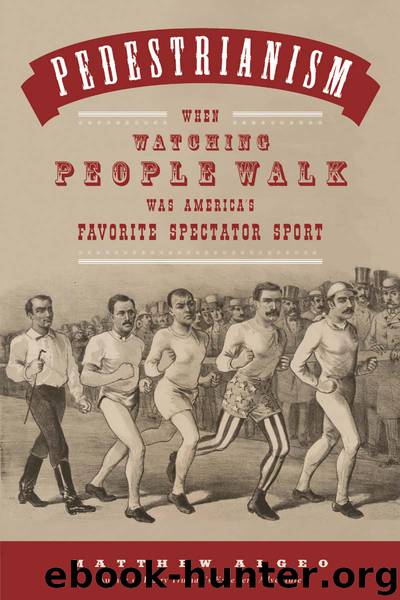Pedestrianism by Matthew Algeo

Author:Matthew Algeo
Language: eng
Format: epub
Publisher: Chicago Review Press
Published: 2014-07-29T16:00:00+00:00
New York City police captain Alexander Williams was nicknamed “Clubber.” GEORGE ARENTS COLLECTION, THE NEW YORK PUBLIC LIBRARY, ASTOR, LENOX AND TILDEN FOUNDATIONS
By 1872, Williams had also acquired a small fortune through bribes and kickbacks, mainly protection money from gambling houses and brothels. This was not an unusual arrangement at the time, but Williams had turned graft into an art form. In 1876, after serving as commander in several low-rent precincts, Williams was assigned to command the prestigious Twenty-Ninth, a precinct centered around Thirtieth Street and Sixth Avenue that encompassed a large swath of Manhattan, including Gilmore’s Garden—and innumerable brothels. It was the center of the city’s nightlife, and Williams was eager for a piece of the action. “I like it fine,” he told a friend when he learned of his new assignment. “I have had chuck for a long time, and now I am going to eat tenderloin.” For generations of New Yorkers thereafter, the neighborhood around Thirtieth and Sixth would be known as the Tenderloin.
In the Tenderloin, Clubber became the czar, ruling with ruth-lessness and impunity. When an eager young cop began shutting down houses of prostitution, Williams intervened. Such businesses, he later explained, were “fashionable.” Besides, Williams said, closing brothels would only force prostitutes onto the streets. “It’s like taking a small-pox patient into the street,” he said, “it merely spreads the disease.”
In 1879, Alexander “Clubber” Williams was at the very apex of his long, colorful, and corrupt career. Gilmore’s Garden was part of his empire, and he would not permit it to be invaded by a mob on the opening day of the prestigious Astley Belt race. When he ordered his men to clear the lobby of the arena, they did not hesitate. With Williams leading the way, the police “rushed into the mob and did terrible execution with their long night clubs,” the Times reported the next day. “The sound of the heavy blows rained upon the defenseless heads and bodies of the unfortunates who happened to be in the front ranks was sickening.” One eyewitness said many “hapless individuals … found themselves borne along by the terrible press of the mob until within reach of the clubs of the Police.”
Swinging savagely, the police beat the throng back out the broken doors and onto Madison Avenue. Then Williams called in reinforcements to clear the street, and a full-scale riot erupted. Pitched battles broke out between truncheon-wielding police and the “angry thousands still smarting from their recent clubbing.” The rioters threw rocks, shattering at least one window in the arena. Some climbed onto the roof of the building. The riot was not merely a manifestation of disappointment at being denied entry to the great walking match. It was also an explicit expression of pent-up rage at the bullying and brutal tactics of the New York Police Department in general—and of Captain Williams in particular.
The riot lasted two hours before the police finally restored order at three o’clock on Monday morning. At least seventy people suffered injuries requiring hospitalization, but, miraculously, no fatalities were reported.
Download
This site does not store any files on its server. We only index and link to content provided by other sites. Please contact the content providers to delete copyright contents if any and email us, we'll remove relevant links or contents immediately.
| Africa | Americas |
| Arctic & Antarctica | Asia |
| Australia & Oceania | Europe |
| Middle East | Russia |
| United States | World |
| Ancient Civilizations | Military |
| Historical Study & Educational Resources |
Cat's cradle by Kurt Vonnegut(14784)
Pimp by Iceberg Slim(13806)
Underground: A Human History of the Worlds Beneath Our Feet by Will Hunt(11848)
4 3 2 1: A Novel by Paul Auster(11818)
The Radium Girls by Kate Moore(11639)
Wiseguy by Nicholas Pileggi(5333)
American History Stories, Volume III (Yesterday's Classics) by Pratt Mara L(5141)
Perfect Rhythm by Jae(5080)
The Fire Next Time by James Baldwin(5033)
Paper Towns by Green John(4811)
Pale Blue Dot by Carl Sagan(4631)
A Higher Loyalty: Truth, Lies, and Leadership by James Comey(4565)
The Mayflower and the Pilgrims' New World by Nathaniel Philbrick(4287)
The Doomsday Machine by Daniel Ellsberg(4253)
Killers of the Flower Moon: The Osage Murders and the Birth of the FBI by David Grann(4195)
Too Much and Not the Mood by Durga Chew-Bose(4104)
The Sympathizer by Viet Thanh Nguyen(4099)
The Borden Murders by Sarah Miller(4032)
Sticky Fingers by Joe Hagan(3916)
